
Mazda Motor Corporation is a Japanese multinational automaker based in Fuchū, Aki District, Hiroshima Prefecture, Japan.

The Mazda MX-3 is a four-seat coupé manufactured and marketed by Mazda, introduced at the Geneva Auto Show in March 1991 and marketed for model years 1992–1998.
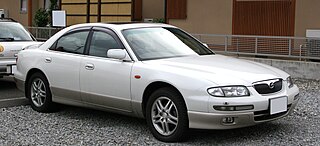
The Mazda Millenia is an automobile which was manufactured by Mazda in Japan from 1993 to 2002.

The Mazda Cosmo is an automobile which was produced by Mazda from 1967 to 1995. Throughout its history, the Cosmo served as a "halo" vehicle for Mazda, with the first Cosmo successfully launching the Mazda Wankel engine. The final generation of Cosmo served as Mazda's flagship vehicle in Japan, being sold as the Eunos Cosmo through its luxury Eunos division in Japan.

The Mazda Capella is a mid-size car that was manufactured by Mazda from 1970 to 2002. Sold in the Japanese domestic market under the Capella name, the vehicle was also commonly known in other major markets as the Mazda 626. Ford, Mazda's partner at the time, would also use the Capella platform to create the Ford Telstar and Ford Probe. 4,345,279 of the 626 and Telstar models were sold worldwide.

The Mazda Luce is an executive car that was produced by Mazda in Japan from 1966 until 1991. It was widely exported as the Mazda 929 from 1973 to 1991 as Mazda's largest sedan. Later generations were installed with luxury items and interiors as the Luce became the flagship offering. The Luce was replaced by the Sentia in 1991 which was also exported under the 929 nameplate.

The Mazda MX-6 is a front-engine, front-wheel-drive coupé manufactured and marketed by Mazda from 1987-1997 across two generations.
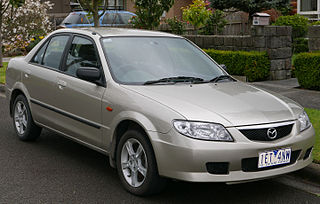
The Mazda Familia, also marketed prominently as the Mazda 323 and Mazda Protegé, is a small family car that was manufactured by Mazda between 1963 and 2003. The Familia line was replaced by the Mazda3/Axela for 2004.
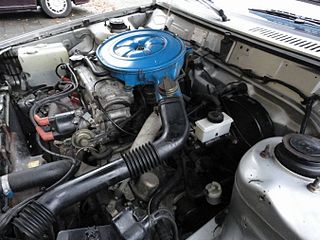
The F engine family from Mazda is a mid-sized inline-four piston engine with iron block, alloy head and belt-driven SOHC and DOHC configurations. Introduced in 1983 as the 1.6-litre F6, this engine was found in the Mazda B-Series truck and Mazda G platform models such as Mazda 626/Capella as well as many other models internationally including Mazda Bongo and Ford Freda clone, Mazda B-series based Ford Courier, Mazda 929 HC and the GD platform-based Ford Probe
The Mazda B-series engine - not to be confused with the Mazda B-Series truck - is a small-sized, iron-block, inline four-cylinder with belt-driven SOHC and DOHC valvetrain ranging in displacement from 1.1 to 1.8 litres. It was used from front-wheel drive economy applications to the turbocharged full-time 4WD 323 GTX and rear-wheel drive Miata as well as numerous other models. The Mazda B-series is a "non-interference" design, meaning that breakage of its timing belt does not result in damage to valves or pistons, because the opening of the valves, the depth of the combustion chamber and the shaping of the piston crown allow sufficient clearance for the open valves in any possible piston position.

The Mazda K-series automobile engine is a short stroke 60° 24-valve V6 with belt-driven DOHC and all-aluminium construction. Displacements range from 1.8 L to 2.5 L. They all use a 27-degree DOHC valvetrain with directly actuated hydraulic bucket lifters. The K-series also features a highly rigid aluminum split-crankcase engine block design with 4-bolt mains with additional bolts securing the lower block, an internally balanced forged steel crankshaft with lightweight powder forged carbon steel connecting rods. They were designed with the intent of being as compact as possible for short-hood front-wheel drive applications.
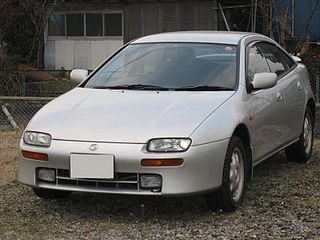
The Mazda Lantis is a series of two cars sold in Japan from 1993 to 1997. In the rest of the world it was also known as 323F, Astina, Allegro Hatchback or Artis Hatchback.

Eunos was a marque of Japanese automaker Mazda, marketed as its upscale, fun to drive line in its home market. The brand existed from 1989 to 1996, when sales operations were integrated into ɛ̃fini.

The Mazda Persona is a mid-sized, front-wheel drive, four-door hardtop sedan produced by Mazda in Japan from November 1988 to December 1991, and sold both within its main range and under its upscale Eunos brand, as the Eunos 300. It is a rebodied Capella/626 with more luxurious equipment. The Persona was Mazda's answer to the Toyota Carina ED, Nissan Presea, and Mitsubishi Emeraude — Japanese sedans that attempted to capture the pillarless hardtop look and proportion of large American sedans. Transposed onto a smaller Japanese sedan, this proportion often led to a small, low cabin in context of longer front and rear ends. It was replaced by the ɛ̃fini MS-8 in March 1992, after Persona stocks had run out. The car was only offered new in the domestic Japanese market.

The Mazda Sentia is a mid-size rear wheel drive luxury car that was sold by Mazda in Japan from 1991 to 1999 over two generations. It replaced the Mazda Luce nameplate on the Mazda H platform, and continued the tradition of being Mazda's largest flagship sedan, which had been in production since the late 1960s.
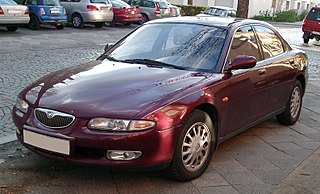
The Mazda Xedos 6 and Eunos 500 are compact executive cars that were produced between 1992 and 1999, with the Xedos 6 being sold in Europe by Mazda, and the Eunos 500 being sold in Japan and Australia by Eunos. The cars were not sold in North America, with the larger Xedos 9/Millenia model offered there instead. In total, 72,101 Xedos 6 and Eunos 500 automobiles were produced.
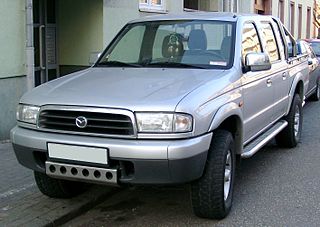
The Mazda B series is a series of pickup trucks that was manufactured by Mazda. Produced across five generations from 1961 to 2006, the model line began life primarily as a commercial vehicle, slotted above a kei truck in size. Through its production, Mazda used engine displacement to determine model designations; a B1500 was fitted with a 1.5 L engine and a B2600, a 2.6 L engine.

Mazda North American Operations (MNAO), which includes Mazda Motor of America, Inc., is Mazda Motor Corporation's North American arm, and constitutes the largest component of that company outside Japan. The company has its headquarters in Irvine, California and is headed by Masahiro Moro.

Amati was a proposed luxury brand announced by Mazda in August 1991 as part of Mazda's expansion plan with the launch of the Autozam, Eunos, and ɛ̃fini marques in hopes of becoming Japan's 3rd largest automaker. It was scheduled to launch in 1994 with the initial range of the Amati 300, a compact executive car equivalent to the Infiniti G20 or the Acura Integra; the Amati 500, an executive car equivalent to the Lexus ES or the Acura Vigor; the Amati 1000, a full-size luxury car equivalent to the Lexus LS400, Acura Legend and the Infiniti Q45, and possibly a full size coupe based on the Eunos Cosmo that would have been equivalent to the Lexus SC400. Mazda invested at least 50 billion yen into the project and had completed development of at least two of the cars, created marketing materials, set up dealers and tooled up an advanced factory in Hofu to produce the cars. However, when the Japanese economy collapsed in early 1992 Mazda faced a liquidity shortage and was unable to complete development of the brand. Mazda announced the cancellation of the Amati brand in October 1992 and the completed vehicles were sold under Mazda's existing brand names.



















